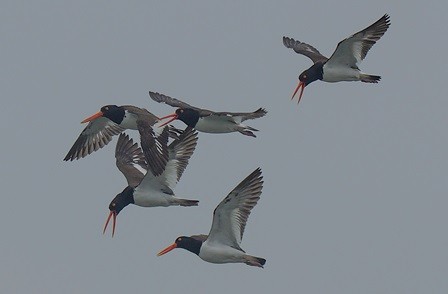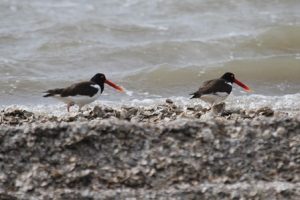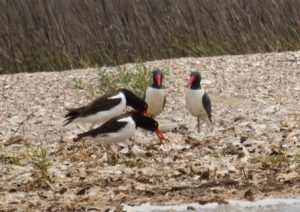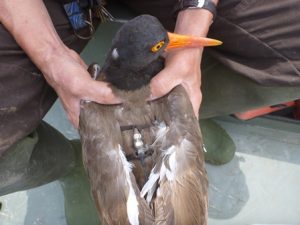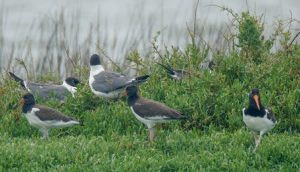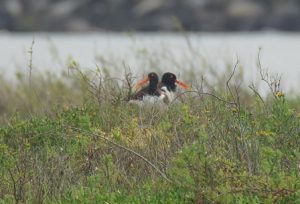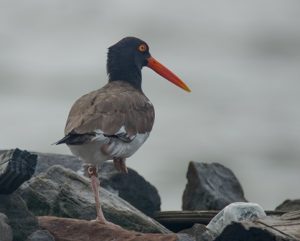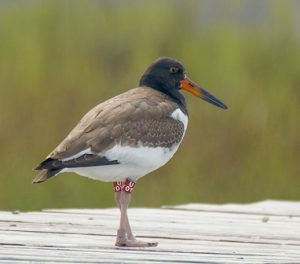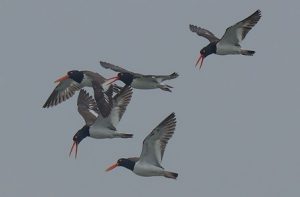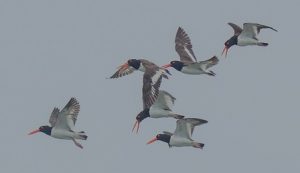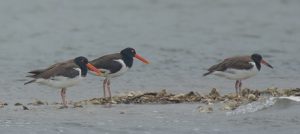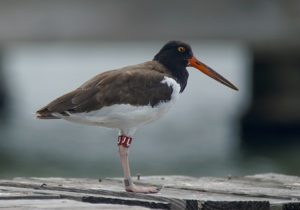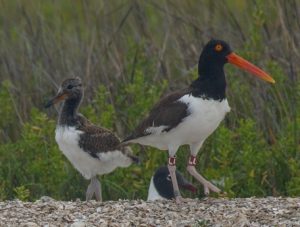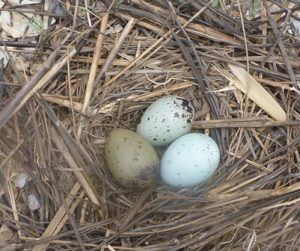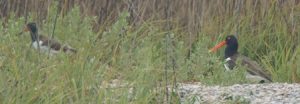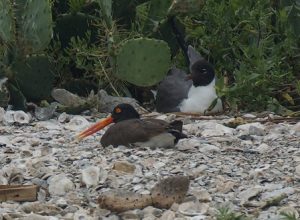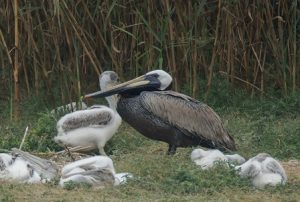By Susan Heath
I had to cancel my trip to East Matagorda Bay on Tuesday because the wind was too high, but on Wednesday I was able to make it out to Bastrop and Drum Bays with Texas Mid-coast NWR Complex biologist Jennifer Wilson. She wanted to check out the colonial waterbird islands there and I haven’t been out there in two years so I really wanted to see how the oystercatchers are doing in that area. We checked out Bastrop Bay first where there were three to four pairs of oystercatchers from 2013 to 2015. Today we found only one. The habitat is severely degraded there and the islands where the oystercatchers used to nest have withered away to almost nothing. It was really sad to see. The pair that was there was J0 & 38. They have been together since 2011 and though I’ve monitored many of their nests, I’ve never seen them with a chick. I am not sure what the problem is. There are a few Laughing Gulls that nest on the island with them as well as some Black Skimmers but it doesn’t seem to be enough that it would cause them to never be able to raise a chick. I really have no idea what’s going on there, but I feel for them. They lay three nests each year and never fledge a chick. I’m surprised the female doesn’t leave.
Next we checked out Drum Bay. From 2013-2015 there were six to seven pairs of oystercatchers nesting here. Today we found only three. AR & unbanded were guarding a one egg nest but not incubating it yet. JK & unbanded had a chick that looked to be about two weeks old! That was happy news. It was too young to band but we’ve planned a return trip to make that happen. I neglected to take any photos of the chick (I was too excited that it was there!). There were rumors that some oyster harvesters had been out hand collecting oysters from the reefs in this bay and that all the activity had caused the herons to abandon the nesting island there. Sure enough we found the island that normally supports hundreds of herons and egrets during the nesting season completely devoid of any birds. Wow. Jennifer took a bunch of notes and we moved on. We didn’t find any other oystercatcher pairs in the area where they normally nested but I remembered that one pair tried to nest on the backside of a GIWW island one time so we headed over there and we found K0 & unbanded guarding a bunch of scrapes. They must have been about ready to lay some eggs. We decided to set up the noose carpets and see what would happen since there was a lot of loose shell there to camouflage them. I normally don’t use the noose carpets if one of the birds is already banded because we’re just as likely to catch the banded one as the unbanded one but in this case, I decided to go for it because I really wanted to put out one of the nanotags on a bird in this bay. The birds kept flying over us calling while we were setting up the carpets so I figured they’d come right in once we got everything set and that is exactly what they did.
It took about 10 minutes but one of them got caught and I was elated to see that it was the unbanded one when we got back over there to collect it. Good deal! She was a hefty girl and we banded her LE which Jennifer decided meant her name was Elle. I thought that was pretty good! I also put a nanotag on her using a harness and off she went back to K0 who had stood by watching with wary eyes the whole time.
On Thursday I went out to West Galveston Bay with John Wright, Alan Wilde and Steve Alexander. Steve is a professor at Texas A&M Galveston and he was eager to see what this oystercatcher stuff is all about. We were happy to show him. Once again the wind was bad news so we headed up to Swan Lake to get that long bay crossing over with before it got worse. On the way we found JK all along guarding his shell pad on the breakwater. I guess his second mate has abandoned him as well. Poor JK! We also found that 20 & 21 have a three egg nest on an island they’ve never nested on before. I always wondered by they didn’t nest there but clearly they considered it substandard habitat until now. I suspect the coyotes are getting their eggs and so they figured a shift was in order. Since we don’t regularly check that island, they could have had this nest for a while.
In Swan Lake we went to check on K7 & unbanded. If you remember, we tried several times to find their chicks to band them and we were never able to so I wasn’t sure if they made it. Well, they did. We found both adults and two chicks snuggled up together. Although we knew they had chicks this is the first time we’ve laid eyes on them. When we got close, the whole family took off and flew to another part of the island. Those sneaky little $@#$%%^! This is not the first time K7 & mate have managed to have their chick(s) elude getting banded. These birds are smart!
It’s great they fledged two chicks though. Great job K7 & mate! R5 & X3 must still have chicks too because they were hanging out up in the vegetation. I wonder if we’ll be able to find those when it comes time to band them!
None of the other pairs up there have nests but we found XC hanging out on the breakwater. XC is a chick from 2013 and was banded on Struve Luci island in West Galveston Bay. It’s parents are 12 & unbanded.
We headed back down to West Galveston Bay to check on everyone down there. On Struve Luci, L8 & L9 were no longer incubating their nest so it either failed or hatched. We couldn’t tell which (more on that in a minute). U0Y was on a dock all by itself and its parents (K6 & JA) and sibling (U4X) were hanging out on the island.
I wonder if that is the oystercatcher equivalent of being put in time out. HM’s unbanded mate was incubating their nest on the rock wall. It got up before Alan could snap a photo of it on the nest. I am rooting for them but I’ll be amazed if that nest makes it. Around the other side of the island, I set up the receiver and checked on U4X’s nanotag. It is still transmitting! When that little guy leaves its parents, hopefully we will learn some things about where it goes. We were hoping to see what was up with L8 & L9 from that side of the island but a roving band of eight oystercatchers flew in and upset the entire apple cart! L8 & L9 flew off to attend the battle and we didn’t get to see from their behavior whether they had chicks or not. Alan got some great flight shots of the rovers.
On Jigsaw I was very happy to see T5, T6, and their chick U3Y out on a reef together. As we approached all three took off and flew. It is a wonderful thing to see a chick fly for the first time!
Nothing happening with the other pairs there. We made our way down to Gangs Bayou and discovered LU still hanging out on the Sportsman Road docks by itself.
On Gangs Bayou we got a quick glimpse of the first pair’s chick. We didn’t see the chicks for the second pair but I’m sure they are still ok because the adults were chasing Laughing Gulls away. These babies will get banded next week if we can figure out how to get to them. TPWD built a very wonderful breakwater between this island and the bay which protects a lot of habitat but makes it difficult for us to get to the island to band chicks. We’ll figure it out though! On South Deer we got great looks at LL (Lyle) & unbanded’s chick. It will be big enough to band in another week.
KK & unbanded have a new nest (third one). Let’s hope it makes it. When I was on my way back from checking their nest, I found this Laughing Gull nest.
It kinda looks like it has an oystercatcher egg, a heron egg, and a gull egg but I’m sure they are all gull eggs. I don’t know what the process is that makes gulls lay eggs that look so different from each other but I’ve seen this more than once.
Y7 & unbanded were hanging out up in the vegetation so perhaps they are sheltering a chick there. 13 was out on a reef feeding and we tried to watch and see if he would bring food back to a chick but the wind pushed us too close and once he saw us, he flew back to his mate calling and so the jig was up. I suspect they have a chick too but we don’t know for sure. Next door, JN & UW were taking it easy while their chick slumbered along the water’s edge. That one is big enough to band next time too and I will put a nanotag on it since we can monitor it easily.
HL (Hal) & L4 appeared from nowhere and landed on a reef when we motored by so we don’t know what’s happening with them either. They could also have an unseen chick.
Over on North Deer and Marker 52 we found UF foraging alone on her nesting island. J6 was absent last week too. I hope he is ok! He’s an old timer and was banded in 2012. There was a bird incubating a new nest on North Deer in JR’s territory but we weren’t able to get photos to see who it was. There’s been some mixing of pairs there and I’m not sure who’s with who. Last week we saw JR & JH together so I suspect that’s who it is but JH has been missing for a while and JR was paired with an unbanded bird earlier in the season. The drama continues.
P4 was alone on her territory too so maybe JJ and P6 were off having a boy’s day off or something. JC was out foraging and there was no sign of H0 so maybe he was off with the boys too. The baby pelicans have reached the white fluffy stage that makes you just want to cuddle them. But be warned – they don’t smell very good!
28 & AP were out feeding on a reef so they haven’t laid a new nest since their last one failed. In Jones Bay we found CA on the Tiki Spoil breakwater again. He acted very shifty last week when we saw him there and he acted the same today. I’m wondering if they have a nest hidden up there somewhere. If so, it will be a tough go of it. That place has become a huge Laughing Gull nursery. P3’s unbanded mate was also acting a bit shifty so I went to check for a new nest but found only scrapes. P3 was over on another reef feeding. We found FR (Fred) & Y2 (the princess) together again on their island that isn’t much more than a reef these days. Y2 has been missing for some time but I guess she decided to come home.
And that was that. Another survey complete. Next week we try to band two sets of chicks. Stay tuned for more oystercatcher drama!
Current Stats for upper Texas coast from Dickinson Bay to East Matagorda Bay: 5 nests being incubated, 34 failed nests, 6 nests with unfledged chicks, 3 nests with undetermined status, 7 chicks fledged
This project is supported by the National Fish and Wildlife Foundation and several private donors. If you would like to contribute you can do so by clicking on the Donate Now button below. All donations are tax deductible and GREATLY appreciated.

